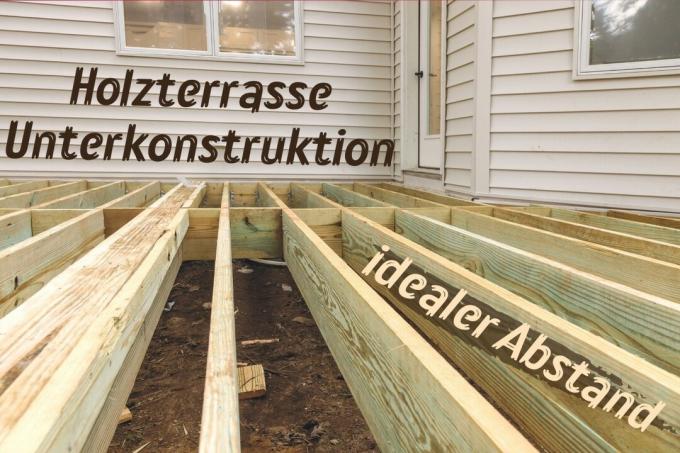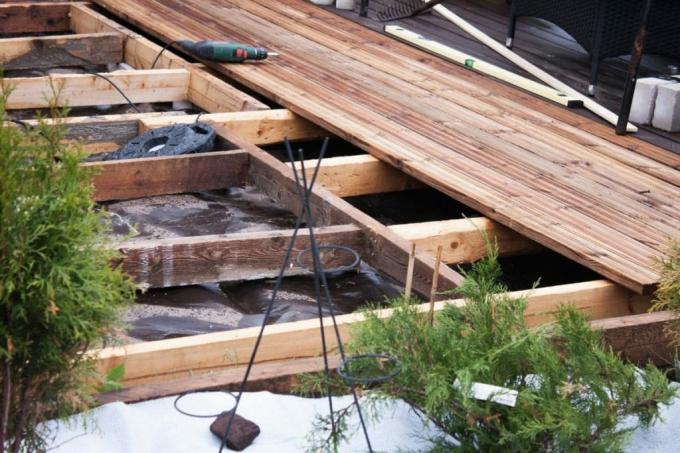
table of contents
- Support beam: ideal spacing
- Note ground clearance
- Distance on impact?
- frequently asked Questions
The substructure for a wooden terrace is essential in order to be able to lay the elements without any problems. The distance between the support beams is particularly important in order to ensure sufficient stability.
In a nutshell
- ideal distance depending on board thickness
- reduces the risk of breakage
- increases stability
- helps to determine the amount of material
- Ground clearance protects against the weather
Support beam: ideal spacing
In order to ensure good stability for the substructure of the wooden terrace, it is important to plan the correct distance between the individual beams. They must not be too far apart, otherwise there is a possible risk of breakage. This is because the planks could sag if they were too far apart. Too short a distance is also not worthwhile, otherwise you will need far too much material. The following values have therefore established themselves as the ideal distance between the individual bars, depending on the material thickness of the decking:
- 40 cm: thickness up to 25 mm
- 50 cm: thickness from 25 mm
This is used as the ideal spacing for the substructure between the individual beams. This point is important, because the total length is often misaligned when measuring from the center of the beam. This means you either order too much or too little material. To make this point clearer and to help you plan, you will find an example of a four meter wide Terrace (board thickness 20 mm), for its substructure, meanwhile, beams with a width of seven centimeters are used will:

- Total width in cm / (bar width in cm + bar spacing in cm) = amount of bars required
- 400 cm / (7 cm + 40 cm) = amount of bars required
- 400 cm / 47 cm = 8.5 bars
- Order 9 bars
Tip: Do not forget the distance to the wall so that the substructure does not lie directly against the wooden terrace. A distance of 15 to 30 millimeters is sufficient for this.
Note ground clearance
You don't just have to consider the distance between the individual bars. The substructure for a wooden terrace, like the boards, must not lie directly on the floor. Otherwise, the material used will be negatively affected by moisture and will have to be replaced over time. The recommended distance from the floor to the substructure is five to six centimeters. This offers several advantages:
- Water flows freely
- good air circulation
At the same time, the floor clearance in combination with the thickness of the beams indicates the height of the substructure. This does not count the selected decking. If the decking is included, it would be the total height of the entire terrace, not just the substructure. If you use beams with a thickness of, for example, 4.5 cm, calculate the floor clearance for the substructure as follows:
- Ground clearance in cm + beam thickness in cm = total height in cm
- 5 or 6 cm + 4.5 cm = 9.5 or 10.5 cm
Note: Make sure you include the required two percent gradient in your planning. The substructure for your wooden terrace must not be completely flat so that rain and melt water can run off.
Distance on impact?
Depending on the size of the planned wooden terrace, you may have to butt-joint support beams that are too short to the substructure. What is meant by this? Butt joint means the seamless laying of two girder beams for the substructure in order to achieve the required length. There is no distance between the bars, so you do not have to pay attention to this. You connect them using flat connectors. For this reason it is important that the material thickness of the beams is exact. In addition, the beams must rest on a foundation foot or stone at the connection point. Otherwise there is a risk that the substructure will break at this point.

Note: Never lay the individual rows with a single, continuous butt joint. In order to improve the stability of this method, you have to move them offset to each other.
frequently asked Questions
The substructure can either be made of wood, aluminum or stainless steel. If you choose wood, weatherproof types are recommended. These include, for example, oak, robinia or larch wood. Many tropical woods such as Bangkirai are also recommended. Aluminum and steel are offered as prefabricated girder beams.
If you opt for the floating construction method, do not fix the substructure to the sub-floor. The substructure for your wooden terrace is built in advance and placed using accessories such as terrace pads. The wooden planks are then screwed to the substructure. This is made possible by the cross-laying type.
Yes, but the ground must be fixed beforehand so that the weight of the wooden terrace does not sink into the ground or shift. A pit is dug, which is filled with a 20 centimeter high layer of gravel or sand and compacted. Compact another layer (5 cm) of gravel or chippings, cover with weed fleece and lay foundation plates.


